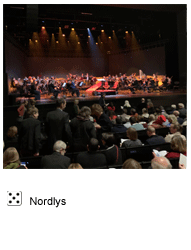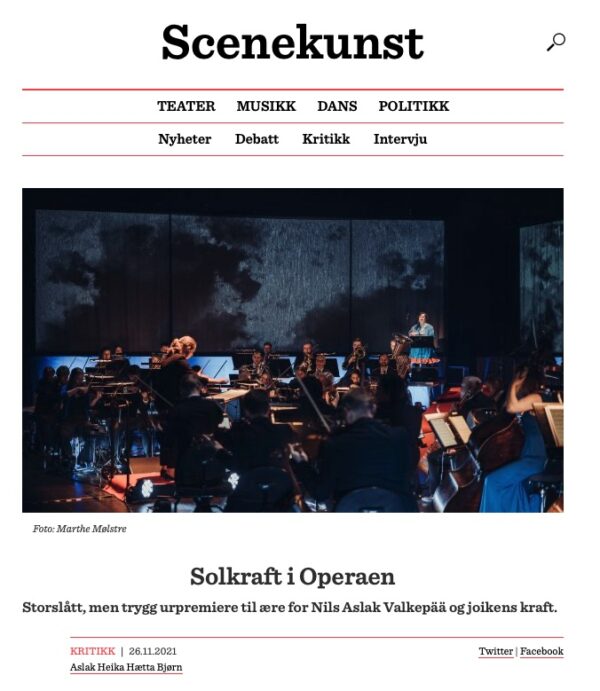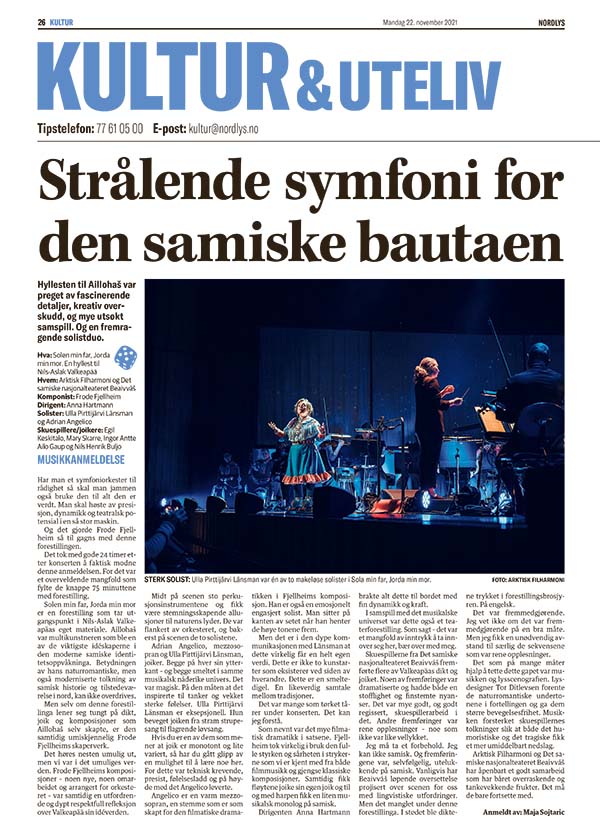
Beaivi, áhčážan, Eanni, eannážan is a worthy tribute to parts of Valkepää's art. The production shows his world of art and poetry, but to an even greater extent it displays Fjellheim as a composer, a composer who shows us how to make classical music on Sami premises.

Without exaggerating, I think we can safely say that large parts of Oslo's Sami population were to be found in Bjørvika on Sunday night, to catch up Beaivi, áhčážan, Eanni, eannážan- The Arctic Philharmonic and the Sami National Theater Beaivváš's tribute to Nils Aslak Valkepää.
The performance is based on the texts from the two cycles of poems: Beaivi, áhčážan (Solen, min far - The Sun, My Father) from 1988 and Eanni, eannážan (Jorda, min mor - The Earth My Mother) from 2001, of which the former was honored with the Nordic Council Literature Prize in 1991.
In the Norwegian society, Nils Aslak Valkeapää, or Áilohaš, is probably best known for the opening ceremony during the Lillehammer Olympics in 1994. On wooden skis, dressed in a white pesk, Valkeapää jogged into the TV room of the majority of the population, before pulling away with a smile on a sleigh behind a slightly wild reindeer.
In Sami society, Valkeapää is known as a poet, yoiker, musician, author, actor, publisher and in many ways the symbol and driving force of the Sami cultural revitalization from the 1970s onwards. Áilohaš was a well-known yoiker long before his debut recording Joikuja in 1968, and even today, 20 years after his death in 2001, Valkeapää is still a kind of ubiquitous force in Sami cultural life. Often referred to as a multi-artist with one foot in tradition and one in avant-garde, Valkeapää brought Sami music into a new era both by mixing traditional yoik with jazz and electronic expressions, but also by working for Sami yoikers and musicians to start their own record companies, labels and associations.
Beaivi, áhčážan, Eanni, eannážan is composed and arranged by Frode Fjellheim, and is directed by Beaivváš's theatrical director Rolf Degerlund. At the start of the performance, we are introduced to the low-key, trance-like cyclical sound from the opening Beaivi, áhčážan (The sun, my father). The stage, the actors and the orchestra are bathed in a sunrise in blue, yellow, green and red - the Sami colors. The play of colors, both in the opening and in the rest of the performance, is effectively put together by lighting designer Tor S. Ditlevsen. Recognizable motifs from Valkeapää's art, such as stars, nature and rock carvings, are projected onto musicians and actors, and for the most part it seems complementary to the expression rather than overshadowing the music.
It does not remain quiet for a long time, though. Less is not always more, and as my sidekick whispers: "I think it's best when they give full throttle". Although the performance is a tribute to Áilohaš, it is unmistakably «Fjellheim-ish», with rhythmic playfulness and tonal elements from vuelie, South Sami yoik. Composer Frode Fjellheim gives us atmospheric and almost spiritual compositions - but he also shows his grasp of the epic, dramatic and grand, similar to the anniversary performance Jielemen aavoe, which Fjellheim wrote for Beaivváš and KORK in 2017, and the super-selling soundtrack from the two Disney Frozenmovies.
Sami cosmos
The lyrics in the performance have been picked by the poet and playwright Rawdna Carita Eira. The excerpts underpin the ideas in the two works the performance is based on. The texts describe the sun and the earth as the basis of life and the life-giving forces, both in a cosmological sense and as the basis for all life, but also as the basis for the Sami people, and for individual life.
Like in romantic operas from the 19th century, the performance paints an epic creation myth, about origin, life and death. At the same time it is a very specific type of life is described, a life lived between the plains of Enontekiö, where Valkeapää grew up, and the Gáisene, the towering mountains by the Lyngenfjord in Ivgubáhta, where he lived his last years. The sun and the earth determine when it is time to give birth and when it is time to die, but perhaps more importantly, when the reindeer herds are to be moved out to the coast, and when it is time to harvest senna grass.
The lyrics are performed by Egil Keskitalo, Mary Sarre, Iŋgor Ántte Áilu Gaup, and Nils Henrik Buljo. Keskitalo and Gaup's playful warmth in particular fit the lyrics well, but with the exception of a costly sequence where the actors whisper about tall gentlemen from the south, the ensemble from Beaivváš has not been given much playroom. Although the production is described as a theatrical encounter between theater and symphony in the preview, the direction bears more trace of recitating Áilohaš´ poetry than theater - which in may be an understandable move, since the performance is a tribute to these texts and yoiks.
The yoik and the symphony.
According to Harald Gaski, the translator for and a close friend of Valkeapää, Valkeapää often referred to yoik as the classical music of the Sami, and he wanted to show in his latest compositions how to use elements from classical music in yoik. I perceive this excitement as an essential part of Fjellheim's project. But rather than showing us how yoik can be classical music, we are shown how symphonic music may incorporate elements of yoik.
The conductor of the evening, Anna Hartmann, brings out both the musical weight and the versatility of the Arctic Philharmonic. Fjellheim's orchestration works well as an accompaniment for the yoiks, but it is more interesting when the orchestra joins the yoik. When the trumpet and strings play a luohtti, or when the mezzo-soprano Adrian Angelico sings yoik syllables in a staccato fashion. Or when several beats are to be heard in the orchestra at the same time, as if to convince the audience that this is yoik; we do not relate to western beats.
The soloists, the yoiker Ulla Pirttijärvi Länsmann from the Finnish side of Sápmi and the Sami mezzo-soprano Adrian Angelico, stand on opposite sides of the stage, and with the orchestra between them they seek to both unite and show the tension between the symphonic soundscape and the yoik's reverberation. Both soloists are very strong - Pirttijävri is recognized as one of the best yoikers of her generation in Sápmi, and Angelico's beautiful mezzo-soprano has given him recognition in opera circles both in Norway and abroad. But the real magic happens when they enter each other's musical domains, like when Angelico puts a soprano voice over Pirttijävri's yoik in the song Jearrat Biekkas.
Touched, but a little unchallenged.
The performance ends with Eannan, Ellima Eadni, which turns into Valkeapää's perhaps most famous yoik Sámi eatnan duoddariid, and a more fitting finale is probably difficult to imagine. Gradually the audience joins in, and it feels consequential and important when the opera is filled with the sound of hundreds of people yoiking the unofficial national yoik in chorus.
The performance conveys the life force of the yoik to the fullest, and its historical and personal meaning for the Sami. But it left me wanting some of the political critisism in the art, and a greater thematization of Valkeapää as a cultural and political figure. What is expressed in the production is first and foremost the national poet and folk artist, not the at times challenging and sometimes inaccessible artist Valkeapää.
Beaivi, áhčážan, Eanni, eannážan is a worthy tribute to parts of Valkepää's art. The production shows his world of art and poetry, but to an even greater extent Fjellheim as a composer, a composer who shows us how to make classical music on Sami premises.
The project is probably not the final proof of the musical relationship between yoik and classical music, but rather it shows that a symphonic orchestra can play yoik just fine. And that is no small feat.
Here is the Nordlys review:

The tribute to Aillohaš was characterized by fascinating details, creative overflow, and many exquisite interactions. And an excellent soloist duo.
What: The sun my father, The Earth my mother. A tribute to Nils-Aslak Valkeapää
Who: Arctic Philharmonic and the Sami National Theater Beaivváš
Composer: Frode Fjellheim
Conductor: Anna Hartmann
Soloists: Ulla Pirttijärvi Länsman and Adrian Angelico
Actors/joikers: Egil Keskitalo, Mary Skarre, Ingor Antte Ailo Gaup and Nils Henrik Buljo
Musical review
If you have a symphony orchestra at your disposal, you should also use it for everything it is worth. One must reap the precision, the dynamic and the theatrical potential of such a large machine.
And that is what Frode Fjellheim really did do with this performance.
I had to let this review ripen for more than 24 after the concert. The show was filled with an overwhelming diversity in the barely 75 minutes of performance.
"The Sun My Father. The Earth My m Mother" is a performance based on Nils-Aslak Valkeapäa's own material. Aillohaš was the multi-artist who became one of the most important creators of ideas in the modern Sami identity awakening. The significance of his romanticism of nature, but also his modernized interpretation of Sami history and presence in the north, cannot be overstated.
But even though this performance leans heavily on poems, yoik and compositions that Aillohaš himself created, it is at the same time unmistakably Frode Fjellheim's creation.
It sounds almost impossible, but we were in the world of the impossible. Frode Fjellheim's compositions - some new, some reworked and arranged for the orchestra - were simultaneously a challenging and deeply respectful reflection on Valkeapää's world of ideas.
The percussional instruments were placed in the middle of the stage and provided evocative allusions to the sounds of nature. They were flanked by the orchestra, and the two soloist were at the back of the stage.
Adrian Angelico, mezzo-soprano, and Ulla Pirttijärvi Länsman, yoiker. Both on their own outer edge - and both fused in the same musically graceful universe. It was magical. In the way that it inspired thoughts and aroused strong emotions. Ulla Pirttijärvi Länsman is exceptional. She moved the yoik from tight throat singing to fluttering leaf singing.
If you are one of those who believe that yoik is monotonous and not very varied, then you missed an opportunity to learn something here. For this was technically demanding, precise, emotional and on a par with what Angelico delivered.
Angelico is a warm mezzo-soprano, a voice that is created for the cinematic drama in Fjellheim's composition. He is also an emotionally engaged soloist. You sit on the edge of the seat when he brings the high notes forward.
But it is in the deep communication with Länsman where this really creates a value of its own. These are not two art forms that exist side by side. This is a crucible. An equal conversation between traditions.
There were many who wiped their tears during the concert. That is understandable.
As mentioned, there was a lot of cinematic drama in the movements. Fjellheim really used the full strength and soreness of the strings that we are familiar with from both film music and current classical compositions. At the same time the flutes got their own yoik and even the harp got a small musical monologue in Sami.
The conductor Anna Hartmann brought all this to the table with great dynamics and power.
This was also a theatrical performance in collaboration with the musical universe. As I said - there was a multitude of impressions to take in, please bear with me.
The actors from the Sami National Theater Beaivváš performed several of Valkeapäa's poems and yoiks. Some of the performances were dramatized and had both a texture and fine-tuned nuances. There was a lot of good and well-directed acting craft. Other performances were pure recitals - which were not as successful.
I have to make a precaution. I do not know Sami. And the performances were, of course, exclusively in Sami. Usually Beaivváš has simultaneous translations projected across the stage for those of us who are linguistically challenged. But this was not the case during this performance. Instead the poems were printed in the performance brochure. In English.
It was alienating. I do not know if it was alienating in a good way. But it created an unnecessary distance, especially to the sequences that were pure readings.
What in many ways helped to close this gap was the music and the lighting design. Lighting designer Tor Ditlevsen united the nature-romantical undertones in the story and gave them greater freedom of movement. The music reinforced the actors' interpretations so that both the humorous and the tragic had a more immediate impact.
The Arctic Philharmonic and the Sami National Theater Beaivváš obviously have a well-functioning collaboration that has borne surprising and thought-provoking fruits. They should keep on doing this.
Reviewed by: Maja Sojtaric






















